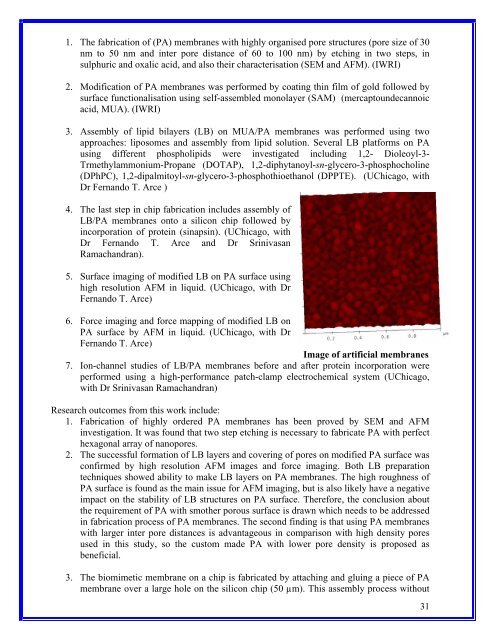Annual Report 2007 - The Australian Nanotechnology Network
Annual Report 2007 - The Australian Nanotechnology Network
Annual Report 2007 - The Australian Nanotechnology Network
You also want an ePaper? Increase the reach of your titles
YUMPU automatically turns print PDFs into web optimized ePapers that Google loves.
1. <strong>The</strong> fabrication of (PA) membranes with highly organised pore structures (pore size of 30<br />
nm to 50 nm and inter pore distance of 60 to 100 nm) by etching in two steps, in<br />
sulphuric and oxalic acid, and also their characterisation (SEM and AFM). (IWRI)<br />
2. Modification of PA membranes was performed by coating thin film of gold followed by<br />
surface functionalisation using self-assembled monolayer (SAM) (mercaptoundecannoic<br />
acid, MUA). (IWRI)<br />
3. Assembly of lipid bilayers (LB) on MUA/PA membranes was performed using two<br />
approaches: liposomes and assembly from lipid solution. Several LB platforms on PA<br />
using different phospholipids were investigated including 1,2- Dioleoyl-3-<br />
Trmethylammonium-Propane (DOTAP), 1,2-diphytanoyl-sn-glycero-3-phosphocholine<br />
(DPhPC), 1,2-dipalmitoyl-sn-glycero-3-phosphothioethanol (DPPTE). (UChicago, with<br />
Dr Fernando T. Arce )<br />
4. <strong>The</strong> last step in chip fabrication includes assembly of<br />
LB/PA membranes onto a silicon chip followed by<br />
incorporation of protein (sinapsin). (UChicago, with<br />
Dr Fernando T. Arce and Dr Srinivasan<br />
Ramachandran).<br />
5. Surface imaging of modified LB on PA surface using<br />
high resolution AFM in liquid. (UChicago, with Dr<br />
Fernando T. Arce)<br />
6. Force imaging and force mapping of modified LB on<br />
PA surface by AFM in liquid. (UChicago, with Dr<br />
Fernando T. Arce)<br />
Image of artificial membranes<br />
7. Ion-channel studies of LB/PA membranes before and after protein incorporation were<br />
performed using a high-performance patch-clamp electrochemical system (UChicago,<br />
with Dr Srinivasan Ramachandran)<br />
Research outcomes from this work include:<br />
1. Fabrication of highly ordered PA membranes has been proved by SEM and AFM<br />
investigation. It was found that two step etching is necessary to fabricate PA with perfect<br />
hexagonal array of nanopores.<br />
2. <strong>The</strong> successful formation of LB layers and covering of pores on modified PA surface was<br />
confirmed by high resolution AFM images and force imaging. Both LB preparation<br />
techniques showed ability to make LB layers on PA membranes. <strong>The</strong> high roughness of<br />
PA surface is found as the main issue for AFM imaging, but is also likely have a negative<br />
impact on the stability of LB structures on PA surface. <strong>The</strong>refore, the conclusion about<br />
the requirement of PA with smother porous surface is drawn which needs to be addressed<br />
in fabrication process of PA membranes. <strong>The</strong> second finding is that using PA membranes<br />
with larger inter pore distances is advantageous in comparison with high density pores<br />
used in this study, so the custom made PA with lower pore density is proposed as<br />
beneficial.<br />
3. <strong>The</strong> biomimetic membrane on a chip is fabricated by attaching and gluing a piece of PA<br />
membrane over a large hole on the silicon chip (50 µm). This assembly process without<br />
31



